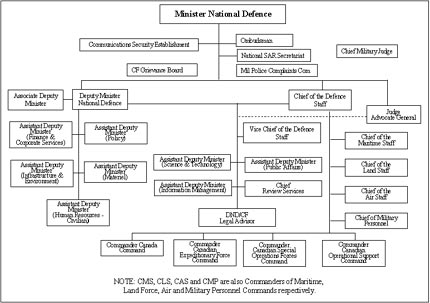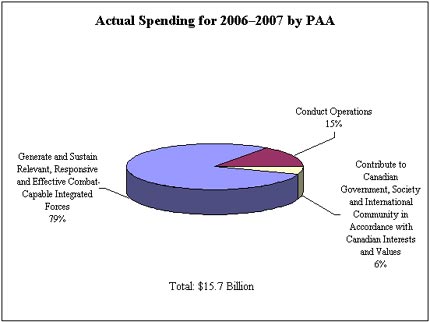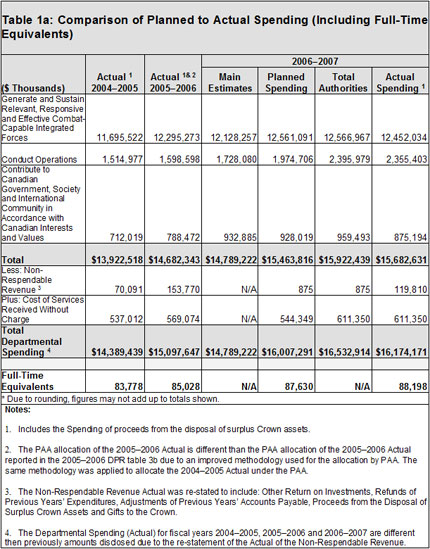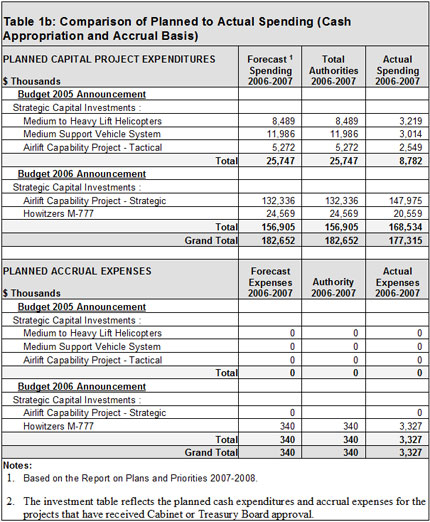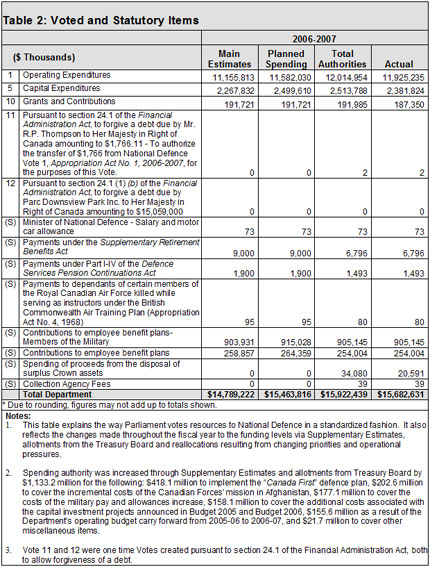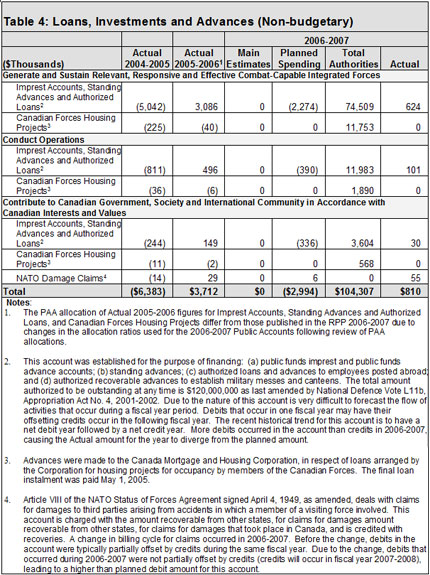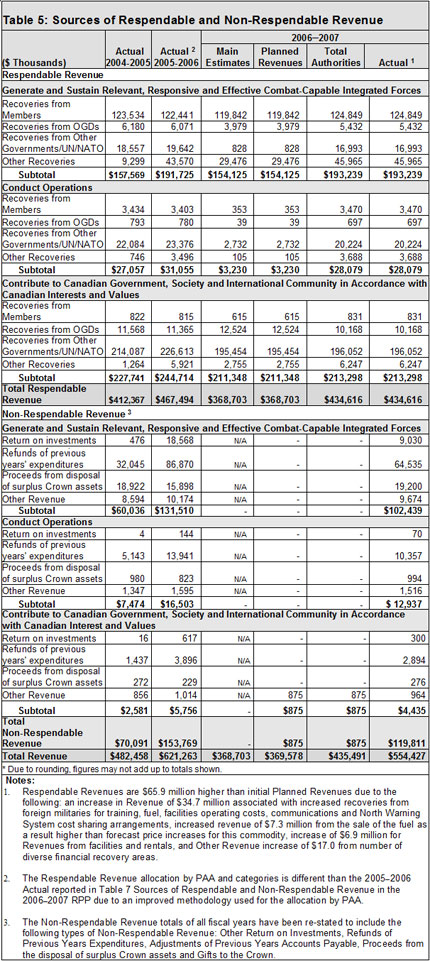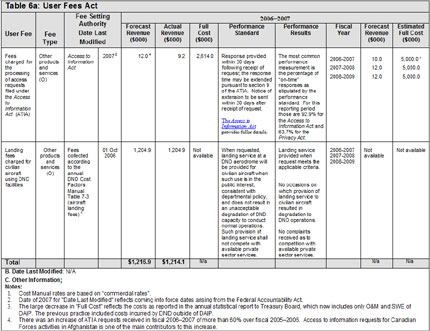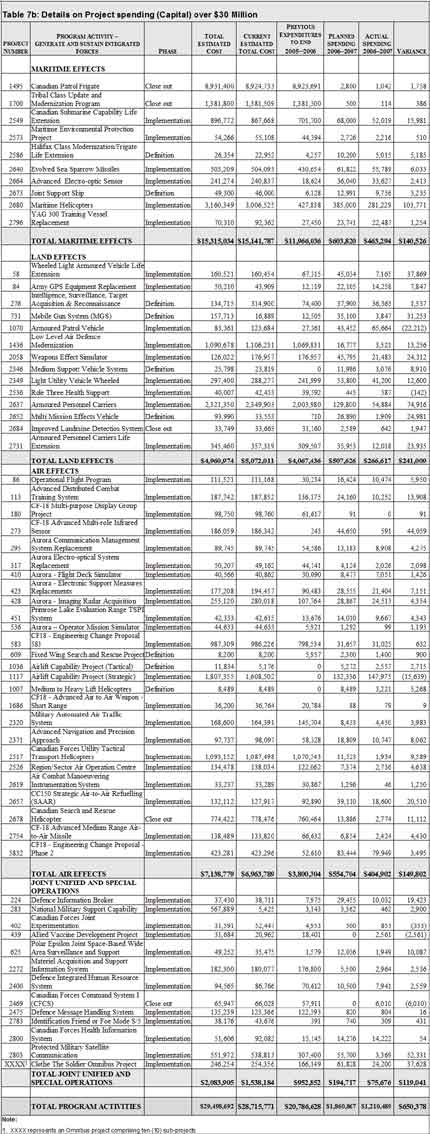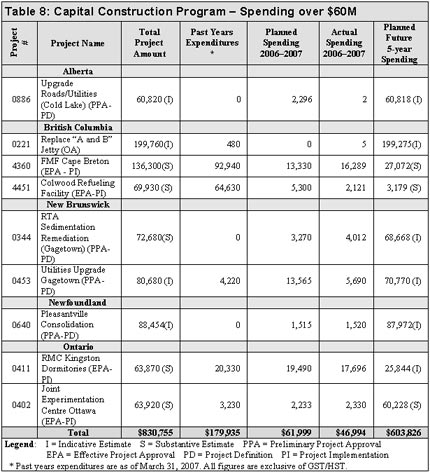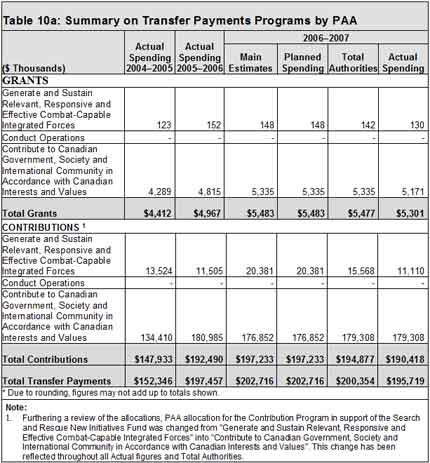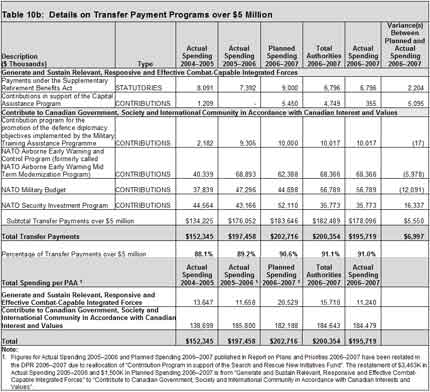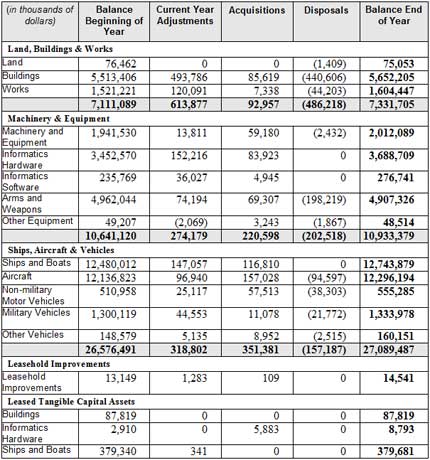Common menu bar links
Breadcrumb Trail
ARCHIVED - National Defence
 This page has been archived.
This page has been archived.
Archived Content
Information identified as archived on the Web is for reference, research or recordkeeping purposes. It has not been altered or updated after the date of archiving. Web pages that are archived on the Web are not subject to the Government of Canada Web Standards. As per the Communications Policy of the Government of Canada, you can request alternate formats on the "Contact Us" page.
Section III: Financial and Human Resources Reporting
Source: Vice-Chief of the Defence Staff Group
Departmental Links to Government of Canada Outcomes Areas
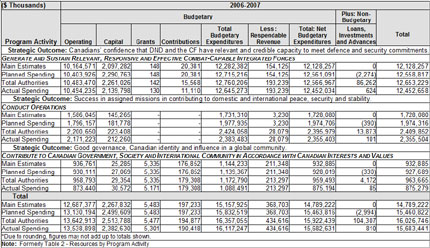
Source: Assistant Deputy Minister(Finance and Corporate Services)Group
Resource Overview for FY 2006–2007
Source: Assistant Deputy Minister(Finance and Corporate Services)Group
Table 1a: Comparison of Planned to Actual Spending (Including Full-Time Equivalents)Source: Assistant Deputy Minister(Finance and Corporate Services)Group
Table 1b: Comparison of Planned to Actual Spending (Cash Appropriation and Accrual Basis)
Source: Assistant Deputy Minister(Finance and Corporate Services)Group
Table 2: Voted and Statutory ItemsSource: Assistant Deputy Minister(Finance and Corporate Services)Group
Table 3: Services Received Without Charge
|
Table 3: Services Received Without Charge |
|
|
($ Thousands) |
2006-2007 |
|
Accommodations provided by Public Works and Government Services Canada |
70,862 |
|
Contributions covering employers' share of employees' insurance premiums |
524,962 |
|
Workers' Compensation paid without charge by Human Resources andSkills Development Canada |
11,657 |
|
Salary and associated expenditures of legal services provided by the Department of Justice Canada |
3,869 |
|
Total 2006-2007 Services Received Without Charge |
$611,350 |
|
Note: *Due to rounding, figures may not add to totals shown. |
|
Source: Assistant Deputy Minister (Finance and Corporate Services) Group
|
Human Resources |
||||
|
Actual 2004 – 2005 |
Actual 2005 – 2006 |
Planned 2006 – 2007 |
Actual 2006 – 2007 |
|
|
Civilian FTEs |
87 |
84 |
84 |
78.6 |
Source: Assistant Deputy Minister(Finance and Corporate Services)Group
Table 4: Loans, Investments and Advances (Non-budgetary)
Source: Assistant Deputy Minister(Finance and Corporate Services)Group
Table 5: Soruces of Respendable and Non-Respendable Revenue
Source: Assistant Deputy Minister(Finance and Corporate Services)Group
Source: Assistant Deputy Minister(Finance and Corporate Services)Group
|
Table 6b: Policy on Service Standards for External Fees – DND FY 2006–2007 |
|||
|
External Fee |
Service Standard | Performance Result |
Stakeholder Consultation |
|
Fees charged for the processing of access requests filed under the Access to Information Act (ATIA) |
Response provided within 30 days following receipt of request; the response time may be extended pursuant to section 9 of the ATIA. Notice of extension to be sent within 30 days after receipt of request. The Access to Information Act provides fuller details. |
The most common performance measurement is the percentage of “on-time” responses as stipulated by the performance standard. For this reporting period those are 92.9% for the Access to Information Act and 63.7% for the Privacy Act. |
The Access to Information Act and the Access to Information Regulations establishes the service standard. The Department of Justice and the Treasury Board Secretariat undertook consultations with stakeholders, for amendments done in 1986 and 1992. |
|
Landing fees charged for civilian aircraft using DND facilities. Fees collected are in accordance with the annual DND Cost Factors Manual Table 7-3 (aircraft landing fees). |
On request, DND will provide landing service at a DND aerodrome for civilian aircraft when such service is in the public interest and consistent with departmental policy. This service shall not result in an unacceptable degradation of capacity to conduct normal operations nor compete with services readily available from the private sector. |
Landing service provided in response to all requests meeting specified criteria. No instances of degradation of DND operational capacity as a result of such service provision. No complaints of competition with services available from the private sector received. |
Agreements with commercial aircraft companies are reviewed on a regular basis. Landing fees collected are in accordance with the DND Cost Factors Manual table applicable to aircraft type/weight and service provided. Complaints as to competition with private sector service providers are investigated and responded to as they arise. |
|
B. Other Information: N/A |
|||
|
Note: The Department of National Defence is charging landing fees to civilian aircraft at the following locations: Goose Bay, Bagotville, Greenwood, Trenton, Moose Jaw, Cold Lake and Comox. |
|||
Source: Assistant Deputy Minister(Finance and Corporate Services)Group
|
($ Thousands) |
Actual |
Actual |
2006–2007 |
||
|
Planned |
Total |
Actual |
|||
|
Defence Services Program |
|||||
|
Generate and Sustain Relevant, Responsive and |
2,018,826 |
2,070,255 |
2,290,763 |
2,261,026 |
2,139,798 |
|
Conduct Operations |
200,260 |
143,159 |
181,778 |
223,408 |
212,260 |
|
Contribute to Canadian Government, Society |
28,844 |
23,987 |
27,069 |
29,354 |
30,572 |
|
Total |
$2,247,930 |
$2,237,401 |
$2,499,609 |
$2,513,788 |
$2,382,630 |
|
Notes:
|
|||||
Source: Assistant Deputy Minister(Finance and Corporate Services)Group
The projects listed in Table 7b below have been identified as either: (1) projects in which the estimated expenditure exceeds the approval authority granted to DND by the Treasury Board ($30 million with substantive cost estimates), or (2) projects in which the risk is particularly high, regardless of the estimated amounts. The list of projects has been divided according to the PAA structure.
Table 7b: Details on Project spending (Capital) over $30 MillionSource: Assistant Deputy Minister (Materiel) Group
Projects listed in Table 8 below have been identified as either: (1) projects in which the estimated expenditures exceeds the approval authority granted to DND by the Treasury Board ($60 million), or (2) projects in which the risk is particularly high regardless of the estimated amounts. All major capital construction projects fall under the Generate and Sustain Program Activity. For fiscal 2006–2007, actual spending on major capital construction projects represented 16.25 percent of the total capital spending in the department. Spending on major construction projects (i.e. projects over $60M) represented 12.1 percent of the overall capital construction spending of $387M.
Table 8: Capital Construction Program - Spending over $60M
For additional information visit the web site on the Federal Real Property and Federal Immovables Act.
| Table 9: Status Report on Major Crown Projects |
|
Supplementary information on the major Crown projects listed below can be found at http://www.tbs-sct.gc.ca/rma/dpr3/06-07/index_e.asp
|
Source: Assistant Deputy Minister (Materiel) Group
Table 10a: Summary on Transfer Payments Programs by PAA
Source: Assistant Deputy Minister(Finance and Corporate Services)Group
Table 10b: Details on Transfer Payment Programs over $5 MillionSource: Assistant Deputy Minister(Finance and Corporate Services)Group
Supplementary information on the transfer payment programs, listed in Table 10b above, can be found at: http://www.tbs-sct.gc.ca/rma/dpr3/06-07/index_e.asp
Source: Vice-Chief of the Defence Staff
|
Supplementary information on the following Alternative Service Delivery programs and/or services can be found at:http://www.tbs-sct.gc.ca/rma/dpr3/06-07/index_e.asp
|
|
Source: Vice-Chief of the Defence Staff Group |
Table 12: Cost of International Operations
Sources: Canadian Expeditionary Force Command (CEFCOM) and Assistant Deputy Minister (Finance and Corporate Services) Groups
| Table 13: Response to Parliamentary Committees, and Audits and Evaluations |
|
RESPONSE TO PARTLIAMENTARY COMMITTEES |
|
On December 7, 2006, the Standing Committee on Public Accounts tabled its 11th Report based on Chapter Two of the May 2006 Report of the Auditor General of Canada (National Defence - Military Recruiting and Retention). The Department worked on the Government Response to the Committee report and the official response will be tabled in the new year. Meanwhile, Defence was asked to report in this DPR on the status of specific recommendations. These can be found in Section II under “Standing Committee on Public Accounts” on pages 34 to 37. As requested in Recommendation 1 of the report, Defence also tabled with the Committee detailed action plans for the implementation of the recommendations made in the SCOPA report before March 31, 2007 as requested. |
|
RESPONSE TO THE AUDITOR GENERAL INCLUDING TO THE COMMISSIONER OF THE ENVIRONMENT AND SUSTAINABLE DEVELOPMENT (CESD) |
|
Office of the Auditor General (OAG) During the reporting period, the Auditor General tabled three Chapters in Parliament that included recommendations directed at the Department of National Defence and the Canadian Forces. Two Chapters tabled in May 2006 were Follow-Ups of chapters that were previously reported in Parliament: “Military Recruiting and Retention” and “NATO Flying. Training in Canada”. In November 2006, the Auditor General tabled a Chapter entitled “Relocating Members of the Canadian Forces, RCMP, and the Federal Public Service”. In the Chapter “Military Recruiting and Retention”, the Auditor General reported that the Department has made satisfactory progress in responding to the audit recommendations that were previously reported in 2002. She also stated, however, that the recruiting system is not fully supporting the needs of the Canadian Forces. Further, she suggested that current recruiting and attrition problems could put the success of the CF’s planned expansion at risk. The Department agreed with the five audit recommendations presented by the Auditor General in this Chapter. In the Chapter “NATO Flying Training in Canada”, the Auditor General also reported that the Department had made satisfactory progress in responding to the recommendations made in 2002 on NATO Flying Training in Canada. She acknowledges that the Department successfully negotiated a settlement with the contractor for training that was missed prior to December 2002. Subsequent to December 2002, however, she noted that the Department paid an additional $39 million for training that was not received. The Department accepted the two audit recommendations presented the Auditor General in this Chapter. In the Chapter “Relocating Members of the Canadian Forces, RCMP, and the Federal Public Service”, the Auditor General reported that the government-wide relocation contract that was awarded to Royal Lepage Relocation Services in November 2004 was not tendered in a fair and equitable manner. In addition, Public Works and Government Services Canada did not take steps to ensure that all bidders in the tendering process had access to correct and complete information. The Auditor General also reported that the Department had not established adequate controls over relocation expenditures. Three of the audit recommendations in this Chapter were directed solely at the Department of National Defence and an additional two were directed at National Defence, along with the Treasury Board Secretariat and/or the RCMP. These three Chapters, including departmental responses to the audit recommendations contained in them, can be accessed on the Auditor General’s website here: http://www.oag-bvg.gc.ca/domino/reports.nsf/html/05menu_e.html Commissioner of the Environment and Sustainable Development In September 2006, the Commissioner of the Environment and Sustainable Development tabled a Report in Parliament that contained two government-wide audit Chapters that made reference to the Department of National Defence. None of recommendations contained in these Chapters were directed at National Defence. These two Chapters were entitled: “Sustainable Development Strategies” and “Environmental Petitions”. These two Chapters can be found on the Commissioner’s website here: http://www.oag-bvg.gc.ca/domino/reports.nsf/html/c2006menu_e.html |
|
External audits |
|
No external audits specifically related to the DND/CF were reported on during fiscal 2006–2007. |
|
INTERNAL AUDITS AND EVALUATIONS |
|
Internal Audits and Evaluations completed during fiscal 2006–2007:
The audit and evaluation reports listed above include recommendations designed to improve the performance of the DND/CF, as well as the management response to them. Completed reports can be found at: http://www.forces.gc.ca/crs/rpt/reports_e.htm |
Source: Assistant Deputy Minister (Policy) Group
The following table includes a number of commitments made by National Defence to green its operations. At the government-wide level, these departmental commitments are co-ordinated by the Office of Greening Government Operations (OGGO) at PWGSC, which includes work toward common governance, measurement, and reporting methods across departments.
|
Table 14: Sustainable Development Strategy (SDS) |
|
|
1. What are the key goals, objectives, and/or long-term targets of the SDS? |
The key goals of Defence’s SDS 2003 are to:
|
|
2. How do your key goals, objectives, and/or long-term targets help achieve your department’s strategic outcomes? |
Defence SDS 2003 looks further out than the three-year cycle of the strategy itself. The target on sustainable military training areas for instance spans the period 2003 to 2010 and has been revised and integrated into the Defence SDS 2006 demonstrating the Department’s continuing support of resource conservation, sound environmental stewardship and good governance. Defence is the government’s largest employer and consumer of goods and services and is one of the largest landholders. As such, the Department acts in compliance with the Government of Canada’s administrative and governance policies, legislation and regulations, and contributes to broader government priorities through responsible stewardship of the assets with which it has been entrusted. Furthermore, in addition to the traditional targets contained in the Defence strategy, SDS 2003 also contained five Commitments to Continual Improvement (untargeted commitments to report on government priorities, such as water consumption) and three legacy Targets (targets that were not met in SDS 2000, but on which we continue to report until they are fully achieved). |
|
3. What were your targets for the reporting period? |
Eleven targets and five Commitments to Continual Improvement are enunciated in Defence SDS 2003 supporting the key goals listed above. In addition, three “legacy” targets that were not fully achieved in the course of SDS 2000; namely, Environmental Management Systems, Integrated Pest Management Plans, and Hazardous Materials Management Plans are outlined. |
|
4. What is your progress to date? |
Of the 11 targets set out in SDS 2003, Defence has exceeded three targets, met three targets, and partially met a further three targets. Two targets were not met. The three targets exceeded are: B.1. (Eliminate or reduce 15 per cent of specified nationally procured High-Risk (HR) Hazardous Materials from use); B.4. (Reduce the Contaminated Sites Liability by 4 per cent per year); and, C.1. (Reduce the Ozone depleting potential of in-service systems and equipment using Halocarbons by 5 per cent); The two targets not met are: B.5. (Minimize the environmental liability associated with petroleum Fuel Storage infrastructure and distribution assets) and B.6. (Minimize the environmental liability associated with Aviation Fuel Storage Capacity); and, None of the three SDS 2000 Legacy targets pursued during SDS 2003 were met: SDS 2000 target A.3. (Develop and implement Integrated Pest Management (IPM) Plans at all Bases /Wings); SDS 2000 target B.1. (Develop and implement Hazardous Material Management Plans at all Bases/Wings/Organizations); and, SDS 2000 target D.1. (Implement Environmental Management Systems).
|
|
5. What adjustments have you made, if any? Discuss how lessons learned have influenced your adjustments. |
With the third year of the three-year reporting cycle for SDS 2003 completed, the Department continues to refine the content of business planning and functional guidance tools to promote innovative activities, including sustainable building, and cost-saving and environmentally sound activities, such as energy performance contracting. National Defence is concerned with the slow progress to address certain targets, for instance the rationalization and upgrading of fuel storage tanks. Many of the lessons learned from these initiatives have been formalised within the new (SDS 2006) iteration of the Defence SDS. In fact, lessons learned during the process of SDS 2003 have led the Department to include all three of the targets that were not reached in fiscal 2006–2007 as commitments in SDS 2006 to further improve our understanding of and performance on these issues. The failure to “close the book” on the SDS 2000 Legacy Targets during this SDS cycle is a cause for increasing concern and will be addressed by continuing to focus on this unfinished business in the latest iteration of the Defence SDS. |
|
Note: DND maintains a consolidated record of all registered storage tanks in a national database. Due to data gaps in this consolidated record, it was not possible to determine compliance with the applicable Technical Guidelines for 521 aboveground tanks and 98 underground tanks. |
|
Source: Assistant Deputy Minister (Infrastructure and Environment) Group
|
Table 15: Procurement and Contracting |
|
Supplementary information on procurement and contracting can be found at : http://www.tbs-sct.gc.ca/rma/dpr3/06-07/index_e.asp.
|
Source: Assistant Deputy Minister (Materiel) Group
|
Supplementary information on storage tanks can be found at : http://www.tbs-sct.gc.ca/rma/dpr3/06-07/index_e.asp.
|
Source: Assistant Deputy Minister (Infrastructure and Environment) Group
|
Table 17: Personnel Requirements – Military (Regular Force) by Program Activity |
||||
|
Program Activity |
Actual 2004 – |
Actual 2005 – |
Planned 2006 – |
Actual 2006 – |
|
Generate and Sustain Integrated Forces |
N/A |
N/A |
56,890 |
56,484 |
|
Conduct Operations |
N/A |
N/A |
5,600 |
6,300 |
|
Contribute to Canada and the International Community |
N/A |
N/A |
971 |
995 |
|
Total |
61,715 |
61,923 |
63,461 |
63,779 |
|
Notes:
|
||||
Source: Chief Military Personnel Group
|
Table 18: Personnel Requirements – Civilian by Program Activity |
||||
|
Program Activity |
Actual |
Actual |
Planned |
Actual |
|
Generate and Sustain Integrated Forces |
20,019 |
20,951 |
20,370 |
22,309 |
|
Conduct Operations |
622 |
688 |
2,3553 |
609 |
|
Contribute to Canada and the International Community |
1,426 |
1,412 |
1,444 |
1,501 |
|
Total2 |
22,0671 |
23,051 |
24,169 |
24,419 |
|
Total (as reported in the RPP/DPR) |
22,0631 |
23,018 |
24,169 |
N/A |
|
Notes:
|
||||
Source: Assistant Deputy Minister (Human Resources-Civilian) Group
|
Table 19: Personnel Requirements – Combined Military (Regular Force) and Civilian by Program Activity |
||||
|
Program Activity |
Actual |
Actual |
Planned |
Actual< |
|
Generate and Sustain Integrated Forces |
N/A |
N/A |
N/A |
78,793 |
|
Conduct Operations |
N/A |
N/A |
N/A |
6,909 |
|
Contribute to Canada and the International Community |
N/A |
N/A |
2,415 |
2,496 |
|
Total |
83,7781 |
84,974 |
87,630 |
88,198 |
|
Notes:
|
||||
Source: Vice-Chief of the Defence Staff Group
|
Table 20: Summary of Military (Regular Force) FTEs by Rank |
|||
|
Rank Structure |
2004 – 2005 |
2005 – 2006 |
2006 – 2007 |
|
General/Lieutenant-General; Admiral, Vice-Admiral |
11 |
12 |
12 |
|
Major-General, Rear-Admiral |
23 |
21 |
20 |
|
Brigadier-General, Commodore |
38 |
44 |
48 |
|
Colonel, Captain(Navy) |
325 |
330 |
323 |
|
Lieutenant-Colonel, Commander |
1,090 |
1,115 |
1,133 |
|
Major, Lieutenant-Commander |
3,192 |
2,247 |
3,280 |
|
Captain, Lieutenant (Navy) |
5,840 |
5,882 |
5,827 |
|
Lieutenant, Second-Lieutenant, Sub-Lieutenant, Acting Sub-Lieutenant |
1,952 |
2,068 |
2,312 |
|
Officer Cadet, Naval Cadet |
1,749 |
1,720 |
1,902 |
|
Chief Warrant Officer, Chief Petty Officer 1st Class |
668 |
674 |
629 |
|
Master Warrant Officer, Chief Petty Officer 2nd Class |
1,803 |
1,861 |
1,907 |
|
Warrant Officer, Petty Officer 1st Class |
3,682 |
3,726 |
2,702 |
|
Sergeant, Petty Officer 2nd Class |
6,760 |
6,802 |
6,782 |
|
Master Corporal, Corporal, Master Seaman, Leading Seaman |
24,632 |
24,681 |
25,155 |
|
Private, Private (Recruit), Able Seaman, Ordinary Seaman |
9,950 |
9,742 |
10,747 |
|
Total |
61,715 |
61,923 |
63,779 |
|
Notes:
|
|||
Source: Assistant Deputy Minister (Information Management) Group
|
Table 21: Summary of Civilian FTEs by Occupational Group |
|||||
|
Capability Program |
Actual |
Actual |
Planned |
Actual |
|
|
OIC Appointments |
4 |
3 |
3 |
4 |
|
|
Executive |
102 |
104 |
109 |
109 |
|
|
Scientific and Professional |
1,870 |
1,993 |
2092 |
2165 |
|
|
Administrative and Foreign Service |
4,948 |
5,328 |
5592 |
5787 |
|
|
Technical |
2,171 |
2,299 |
2413 |
2456 |
|
|
Administrative Support other than Clerical |
630 |
601 |
630 |
574 |
|
|
Clerical and Regulatory |
3,256 |
3,398 |
3568 |
3628 |
|
|
Operational other than General Labour and General Services |
2,290 |
2,370 |
2489 |
2574 |
|
|
General Labour and Trades |
3,032 |
3,106 |
3260 |
3109 |
|
|
General Services |
2,188 |
2,214 |
2325 |
2293 |
|
|
Other (Students, Minister's Staff, Unknown) |
148 |
139 |
143 |
149 |
|
|
Communications Security Establishment (CSE) staff - (executives and non-executives) |
1,424 |
1,492 |
1567 |
1578 |
|
|
Total1 |
22,063 |
23,047 |
24,191 |
24,426 |
|
|
Note: 1. Differences in totals between this table and previous RPP/DPR input are due to missing cost centres and a move to the PAA structure. |
|||||
Source: Assistant Deputy Minister (Human Resources-Civilian) Group
Table 22: Financial Statements for the Department of National Defence
Statement of Management Responsibility
Responsibility for the integrity and objectivity of the accompanying financial statements for the year ended March 31, 2007 and all information contained in these statements rests with the management of National Defence. These financial statements have been prepared by management in accordance with Treasury Board accounting policies which are consistent with Canadian generally accepted accounting principles for the public sector.
Management is responsible for the integrity and objectivity of the information in these financial statements. Some of the information in the financial statements is based on management’s best estimates and judgment and gives due consideration to materiality. To fulfil its accounting and reporting responsibilities, management maintains a set of accounts that provide a centralized record of the department’s financial transactions. Financial information submitted to the Public Accounts of Canada and included in the department’s Departmental Performance Report is consistent with these financial statements.
Management maintains a system of financial management and internal control designed to provide reasonable assurance that financial information is reliable, assets are safeguarded, transactions are in accordance with the Financial Administration Act and are executed in accordance with prescribed regulations, within Parliamentary authorities, and are properly recorded to maintain accountability of Government funds. Management also seeks to ensure the objectivity and integrity of data in its financial statements by careful selection, training and development of qualified staff, by organizational arrangements that provide appropriate divisions of responsibility and by communication programs aimed at ensuring that regulations, policies, standards and managerial authorities are understood throughout National Defence.
The financial statements of the Department have not been audited. There is no current requirement for National Defence to have these statements audited.
| Ward Elcock Deputy Minister |
RAdm Bryn Weadon, CMA Senior Financial Officer |
| Ottawa, Canada |
Date: July 27, 2007
Statement of Operations (Unaudited)
For the year ended March 31
|
(in thousands of dollars) |
2007 |
2006* |
|
Expenses (Note 4) |
|
|
|
Generate and Sustain Relevant, Responsive and |
12,552,623 |
13,197,635 |
|
Conduct Operations |
2,313,180 |
1,351,719 |
|
Contribute to Canadian Government, Society and International Community in Accordance with Canadian Interests and Values |
1,106,068 |
1,042,235 |
|
15,971,871 |
15,591,589 |
|
|
Revenues (Note 5) |
|
|
|
Generate and Sustain Relevant, Responsive and |
208,187 |
305,398 |
|
Conduct Operations |
24,784 |
36,090 |
|
Contribute to Canadian Government, Society and International Community in Accordance with Canadian Interests and Values |
215,376 |
154,680 |
|
448,347 |
496,168 |
|
|
Net Cost Of Operations |
15,523,524 |
15,095,421 |
* Comparative figures have been reclassified to conform to the current year's Program Activity Architecture structure. Refer to Note 2(c) of these financial statements.
The accompanying notes form an integral part of these financial statements.
Statement of Financial Position (Unaudited)
As at March 31
|
(in thousands of dollars) |
2007 |
2006 |
|
Assets |
||
|
Financial Assets |
||
|
Receivables (Note 6) |
168,000 |
634,186 |
|
Loans and Advances (Note 7) |
30,752 |
29,942 |
|
198,752 |
664,128 |
|
|
|
|
|
|
Non-Financial Assets |
|
|
|
Prepaid Expenses (Note 8) |
863,604 |
517,512 |
|
Inventories (Note 9) |
5,192,436 |
4,955,682 |
|
Tangible Capital Assets (Note 10) |
26,137,296 |
25,921,679 |
|
32,193,336 |
31,394,873 |
|
|
|
|
|
|
32,392,088 |
32,059,001 |
|
|
|
|
|
|
Liabilities |
|
|
|
Accounts Payable and Accrued Liabilities |
1,820,680 |
1,732,901 |
|
Vacation Pay and Compensatory Leave |
221,449 |
168,072 |
|
Deposits and Trust Accounts (Note 11) |
1,868 |
2,215 |
|
Deferred Revenue (Note 12) |
67,597 |
61,886 |
|
Canadian Forces Pension and Insurance Accounts (Note 13) |
43,700,028 |
42,720,547 |
|
Lease Obligations for Tangible Capital Assets (Note 14) |
759,903 |
832,612 |
|
Severance Benefits (Note 15) |
1,350,019 |
1,271,768 |
|
Environmental Liabilities (Note 16) |
497,416 |
442,977 |
|
|
|
|
|
48,418,960 |
47,232,978 |
|
|
|
|
|
|
Equity of Canada |
(16,026,872) |
(15,173,977) |
|
32,392,088 |
32,059,001 |
Contingent Liabilities (Note 16)
Contingent Gain (Note 17)
Contractual Obligations (Note 18)
The accompanying notes form an integral part of these financial statements.
Statement of Equity of Canada (Unaudited)
For the year ended March 31
|
(in thousands of dollars) |
2007 |
2006 |
|
Equity of Canada, beginning of year |
(15,173,977) |
(14,845,341) |
|
|
|
|
|
Net Cost of Operations |
(15,523,524) |
(15,095,421) |
|
Current Year Appropriations Used (Note 3) |
15,682,630 |
14,682,343 |
|
Revenue Not Available for Spending |
(97,949) |
(132,002) |
|
Change in Net Position in the Consolidated Revenue Fund |
(1,525,402) |
(352,630) |
|
Services Provided Without Charge by Other Government Departments (Note 19) |
611,350 |
569,074 |
|
|
|
|
|
Equity of Canada, end of year |
(16,026,872) |
(15,173,977) |
The accompanying notes form an integral part of these financial statements.
Statement of Cash Flow (Unaudited)
For the year ended March 31
|
(in thousands of dollars) |
2007 |
2006 |
|
Operating Activities |
||
|
Net Cost of Operations |
15,523,524 |
15,095,421 |
|
Non-Cash Items Included in Net Cost of Operations: |
|
|
|
Amortization of Tangible Capital Assets |
(1,783,758) |
(1,748,330) |
|
Gain or Loss on Disposals / Adjustments of Tangible Capital Assets |
(221,636) |
(290,416) |
|
Services Provided Without Charge by Other Government Departments |
(611,350) |
(569,074) |
|
Variations in Statement of Financial Position |
|
|
|
Increase (decrease) in Receivables and Advances |
(465,376) |
404,471 |
|
Increase in Prepaid Expenses |
346,092 |
36,657 |
|
Increase in Inventories |
236,754 |
55,319 |
|
Increase in Liabilities, net of Capital Lease Obligations |
(1,258,691) |
(836,464) |
|
Cash Used by Operating Activities |
11,765,559 |
12,147,584 |
|
|
|
|
|
Capital Investment Activities |
|
|
|
Acquisitions of Tangible Capital Assets (excluding Leased Tangible Capital Assets) (Note 10) |
2,235,599 |
1,983,092 |
|
Proceeds on Disposal of Surplus Assets |
(20,471) |
(17,895) |
|
Payments against / Adjustments to Capital Lease Obligations |
78,592 |
84,930 |
|
Cash Used by Capital Investment Activities |
2,293,720 |
2,050,127 |
|
|
|
|
|
Financing Activities |
|
|
|
Net Cash Provided by Government of Canada |
(14,059,279) |
(14,197,711) |
The accompanying notes form an integral part of these financial statements.
Note 1. Authorities and Objectives
Authorities
The Department of National Defence (DND) was established by the National Defence Act (NDA). Under section 3 of the Act, the Minister of National Defence presides over the Department. Under section 4 of the NDA, the Minister has the management and direction of the Canadian Forces (CF) and of all matters relating to National Defence.
Objectives
The Defence mission is to defend Canada and Canadian interests and values while contributing to international peace and security. Under Canadian defence policy, the CF is called upon to fill three major roles: protecting Canada, defending North America in co-operation with the United States, and contributing to international peace and security. The Defence mission is delivered through three Program Activities, which are as follows:
(a) Generate and Sustain Relevant, Responsive and Effective Combat-Capable Integrated Forces:
This program activity consists of all the activities necessary to design and develop force structure, create the capability components, generate the forces, and sustain and maintain the forces over time at the appropriate readiness levels. It is designed to generate and sustain forces capable of: Maritime Effects; Land Effects; Aerospace Effects; and Joint, National, Unified and Special Operations Forces. This activity is required to:
- Maintain operational units;
- Maintain deployable support;
- Recruit and train personnel;
- Provide nationally based fixed support including infrastructure, supply, fixed command, force development, and research and development; and
- Acquire Capital Equipment.
(b) Conduct operations:
This Program Activity represents the main use of the program output from generate and sustain forces, that is the employment of forces in operations, whether on a constant basis, selectively ongoing operations, or as required for named domestic or international operations. It consists of all the activities necessary to conduct: Constant Situational Awareness; Domestic and
Continental Operations; and International Operations.
This activity is required to:
- Maintain and conduct Intelligence, surveillance and reconnaissance (ISR) operations;
- Maintain ISR support;
- Employ forces to conduct contingency operations in response to domestic or continental requirements;
- Employ High–Readiness forces to conduct operations in response to domestic and continental requirements;
- Provide ongoing specified services in accordance with Government of Canada and other government department agreements and demand from other levels of government;
- Employ forces to conduct contingency operations in response to international requirements; and
- Employ High–Readiness forces to conduct operations in response to international requirements.
(c) Contribute to Canadian government, society and international community in accordance with Canadian interests and values:
This Program Activity consists of Defence advice to the Government of Canada, contributions to Canadian Government; and contributions to the International Community, all in accordance with Canadian interests and values. This activity is required to:
- Provide defence and security policy advice to the Government of Canada;
- Provide military advice to the Government of Canada;
- Provide support to Government of Canada programs;
- Contribute to Canadian economy and innovation;
- Contribute to Canadian identity;
- Contribute to youth and education;
- Meet commitments to international organizations and exchange programs; and
- Provide advisory and training support to other nations.
Note 2. Summary of Significant Accounting Policies
The financial statements have been prepared in accordance with Treasury Board accounting policies, which are consistent with Canadian generally accepted accounting principles for the public sector.
(a) Parliamentary Appropriations
The Department is financed by the Government of Canada through Parliamentary appropriations. Appropriations provided to the Department do not parallel financial reporting according to generally accepted accounting principles since appropriations are primarily based on cash flow requirements. Consequently, items recognized in the statement of operations and the statement of financial position are not necessarily the same as those provided through appropriations from Parliament. Note 3 provides a high-level reconciliation between the bases of reporting.
(b) Reporting Entity
The reporting entity hereafter referred to, as the Department, is comprised of DND, the CF and several related organizations and agencies in the Defence Portfolio, which carry out the Defence mission and are part of the Defence Services Program. The Canadian Forces Grievance Board and the Military Police Complaints Commission are excluded from the reporting entity because these organizations are not part of the Defence Services Program, although they fall under the responsibility of the Minister of National Defence.
Non-Public Property (NPP) as defined in section 2 of the NDA, and administered by the Canadian Forces Personnel Support Agency is also excluded from the reporting entity. NPP includes all money and property contributed to or by CF members for their collective benefit and welfare. NPP is not subject to the Financial Administration Act, and is administered outside the framework of public funds. NPP is not part of the Defence Services Program. For 2006-2007 NPP had estimated annual revenues of $330 million, estimated annual expenses of $295 million and as of March 31, 2007 had an estimated net equity (assets minus liabilities) of $540 million.
Organizations and agencies that are part of the reporting entity include the following:
- Canadian Cadet Program and the Junior Canadian Rangers;
- Communications Security Establishment;
- Canadian Forces Housing Agency;
- Defence Research and Development Canada;
- Office of the Communications Security Establishment Commissioner;
- Office of the Department of National Defence and Canadian Forces Ombudsman;
- Office of the Judge Advocate General; and
- National Search and Rescue Secretariat.
All revenue and expense transactions and any related asset and liability accounts between organizations within the Defence Services Program have been eliminated.
(c) Basis of Financial Reporting
In 2006-2007, National Defence implemented a new Program Activity Architecture (PAA), which is subject to refinement. The activities used for this new PAA are identified in Note 1 under objectives.
(d) Net Cash Provided by the Government of Canada
The department operates within the Consolidated Revenue Fund (CRF), which is administered by the Receiver General for Canada. All cash receipts are deposited to the CRF and all cash disbursements made by the Department are paid from the CRF. Net cash provided by the Government is the difference between all cash receipts and cash disbursements including transactions between departments of the federal government.
(e) Change in Net Position in the Consolidated Revenue Fund
Change in net position in the CRF is the difference between the net cash provided by Government and appropriations used in a year, excluding the amount of non-respendable revenue recorded by the department. It results from timing differences between when a transaction affects appropriations and when it is processed through the CRF.
(f) Revenues
- Revenues are accounted for in the period in which the underlying transaction or event occurred that gave rise to the revenues;
- Funds received from external parties for specified purposes are recorded upon receipt as deferred revenues. These revenues are recognized in the period in which the related expenses are incurred; and
- Revenues that have been received but not yet earned are recorded as deferred revenues.
(g) Expenses
Expenses are recorded on an accrual basis:
- Grants are recognized in the year in which the conditions for payment are met. In the case of grants, which do not form part of an existing program, the expense is recognized when the Government announces a decision to make a non-recurring transfer, provided the enabling legislation or authorization for payment receives parliamentary approval prior to the completion of the financial statements;
- Contributions are recognized in the year in which the recipient has met the eligibility criteria and fulfilled the terms and conditions of the funding agreement;
- Vacation pay and compensatory leave are expensed as the benefits accrue to employees under their respective terms of employment; and
- Services provided without charge by other government departments for accommodation, the employer’s contribution to the health and dental insurance plans, Worker’s Compensation coverage and legal services are recorded as operating expenses at their estimated cost.
(h) Employee Future Benefits
(i) Pension Benefits
Eligible civilian employees participate in the Public Service Pension Plan, a multi-employer plan administered by the Government of Canada. Contributions to the Plan are charged to expenses in the year incurred and represent the total departmental obligation to the Plan. Current legislation does not require the Department to make contributions for any actuarial deficiencies of the Plan.
The Government of Canada sponsors a variety of employee future benefits such as pension plans and disability benefits, which cover members of the Canadian Forces. National Defence administers the pension benefits for members of the Canadian Forces. The actuarial liability and related disclosures for these future benefits are presented in the financial statements of the Government of Canada. This differs from the accounting and disclosures of future benefits for military members presented in these financial statements whereby pension expense corresponds to the Department’s annual contributions toward the cost of current service. In addition to its regular contributions, current legislation also requires the Department to make contributions for actuarial deficiencies in the Canadian Forces Pension Plan and in the Reserve Force Pension Plan, which came into force on March 1, 2007. These contributions are expensed in the year they are credited to the Plans. This accounting treatment corresponds to the funding provided to departments through Parliamentary appropriations.
(ii) Severance Benefits
Employees and military members are entitled to severance benefits, under labour contracts or conditions of employment. These benefits are accrued as employees and military members render the services necessary to earn them. The obligation relating to the benefits earned by civilian employees and Canadian Forces members is calculated using information derived from the results of the actuarially determined liability for employee severance benefits for the Government as a whole.
(i) Receivables
Receivables are stated at amounts expected to be ultimately realized. An allowance for bad debts is made for external receivables where recovery is considered uncertain.
(j) Loans and Advances
Loans and advances are stated at amounts expected to be ultimately realized; a provision is made where recovery is considered uncertain.
(k) Inventories
Inventory consists of consumables (such as non-repairable spares, uniforms and clothing, medical and other equipment and machine tools) and ammunition (including bombs and missiles). Consumable inventories are valued using a moving weighted average price methodology. Some items classified as repairable ammunition (e.g. missiles and torpedoes) are valued using a standard price. Inventory managed by contractors and not held in the Canadian Forces Supply System is valued based on contractor-supplied records. DND reviews its inventory on a periodic basis. Items identified for disposal are excluded from the value of inventory.
(l) Tangible Capital Assets
All tangible capital assets, having an initial cost of $30,000 or more, including capital leases, betterments and leasehold improvements, are recorded at their acquisition cost. Capitalization threshold values lower than $30,000 may apply to certain assets such as vehicles and repairable spares.
Capital assets do not include intangible assets, works of art and historical treasures that have cultural, aesthetic or historical value, assets located on First Nations Reserves and museum collections.
The department is presently reviewing its process for recording and valuation of tangible capital assets. This work will be conducted over a number of years. In 2006-2007, DND identified and recorded $146 million in post-capitalization of tangible capital assets as current year transactions.
(m) Amortization of Tangible Capital Assets
Amortization of tangible capital assets is done on a straight-line basis over the estimated useful life of the capital asset as follows:
|
Asset Class |
Amortization Period |
|
Buildings |
10-40 years |
|
Works |
5-40 years |
|
Machinery and Equipment |
3-30 years |
|
Informatics Hardware |
3-30 years |
|
Informatics Software |
2-12 years |
|
Arms and Weapons |
3-30 years |
|
Other Equipment |
5-30 years |
|
Ships and Boats |
10-30 years |
|
Aircraft |
20-40 years |
|
Non-military Motor Vehicles |
2-30 years |
|
Military Vehicles |
3-25 years |
|
Other Vehicles |
4-25 years |
|
Leasehold Improvements |
Lesser of useful life of the improvement or term of lease |
|
Leased Tangible Capital Assets |
Economic life or term of lease |
|
Repairable spares are amortized in accordance with the sum of the accumulated amortization of the equipment platform that they support. |
|
(n) Contingent Liabilities – Claims and Litigations
Contingent liabilities are potential liabilities, which may become actual liabilities when one or more future events occur or fail to occur. To the extent that the future event is likely to occur or fail to occur, and a reasonable estimate of the loss can be made, an estimated liability is accrued and an expense recorded. If the likelihood is not determinable or an amount cannot be reasonably estimated, the contingency is disclosed in the notes to the financial statements. (refer to Note 16(a) of these financial statements)
(o) Environmental Liabilities
Environmental liabilities reflect the estimated costs related to the management and remediation of environmentally contaminated sites and unexploded explosive ordnance (UXO) affected sites. Based on management’s best estimates, a liability is accrued and an expense recorded associated with the site assessment activity, when a site becomes contaminated or affected or when the Department becomes aware that the site has become contaminated or affected and is obligated, or is likely to be obligated, to incur such costs. If the likelihood of the Department’s obligation to incur these costs is not determinable, or if an amount cannot be reasonably estimated, the costs are disclosed as contingent liabilities in the notes to the financial statements. (refer to Note 16(b) of these financial statements)
(p) Foreign Currency Transactions
Transactions involving foreign currencies are translated into Canadian dollar equivalents using rates of exchange in effect at the time of those transactions. Monetary assets and liabilities denominated in foreign currencies are translated into Canadian dollars using the rate of exchange in effect on March 31, 2007. Gains resulting from foreign currency transactions are included as revenues in Interest and Gains on Foreign Exchange in Note 5 and losses from foreign currency transactions are included in Other Expenses in Note 4.
(q) Measurement Uncertainty
The preparation of these financial statements, in accordance with Treasury Board accounting policies, which are consistent with Canadian generally accepted accounting principles for the public sector, requires management to make estimates and assumptions that affect the reported amounts of assets, liabilities, revenues and expenses reported in the financial statements. At the time of preparation of these statements, management believes the estimates and assumptions to be reasonable. The most significant items where estimates are used are contingent liabilities, environmental liabilities, the liability for employee severance benefits and the useful life of tangible capital assets. Actual results could significantly differ from those estimates. Management’s estimates are reviewed periodically and, as adjustments become necessary, they are recorded in the financial statements in the year they become known.
Note 3. Parliamentary Appropriations
National Defence receives most of its funding through annual Parliamentary appropriations. Items recognized in the Statement of Operations and the Statement of Financial Position in one year may be funded through Parliamentary appropriations in prior, current and future years. Accordingly, the Department has different net results of operations for the year on a government funding basis than on an accrual accounting basis. The differences are reconciled in the following tables:
3 (a) Reconciliation of Net Cost of Operations to Current Year Appropriations Used
|
(in thousands of dollars) |
2007 |
2006 |
|
Net Cost of Operations |
15,523,524 |
15,095,421 |
|
Adjustments for items affecting Net Cost of Operations |
|
|
|
Amortization of Tangible Capital Assets |
(1,783,758) |
(1,748,330) |
|
Services Provided Without Charge by Other Government Departments |
(611,350) |
(569,074) |
|
Severance Benefits |
(78,251) |
(133,591) |
|
Refund of Previous Year’s Expenses |
77,786 |
104,707 |
|
Vacation Pay and Compensatory Leave |
(53,377) |
53,278 |
|
Gain or Loss on Disposals and Adjustments of Capital Assets |
(221,636) |
(290,416) |
|
Return on Investments |
9,400 |
19,330 |
|
Other Revenues |
7,966 |
12,782 |
|
Justice Canada Fees |
(6,110) |
(5,314) |
|
Environmental Liabilities and Other Allowances |
(55,833) |
8,384 |
|
Allowance of Bad Debts |
(8,532) |
(3,548) |
|
Sale of Real Property through Canada Lands Company |
2,930 |
0 |
|
Miscellaneous |
12 |
5 |
|
(2,720,753) |
(2,551,787) |
|
|
|
|
|
|
Adjustments for items not affecting Net Cost of Operations but affecting Appropriations |
|
|
|
Tangible Capital Assets Acquisitions (excluding capital leases) |
2,235,599 |
1,983,092 |
|
Payments Against Capital Lease Obligations |
79,100 |
85,410 |
|
Inventory Purchases Net of Usage and Adjustments |
236,754 |
55,320 |
|
Net Variation Prepaid Expenses |
346,092 |
36,657 |
|
Revenues Collected from Prior Year Receivables |
(17,686) |
(21,770) |
|
2,879,859 |
2,138,709 |
|
|
|
|
|
|
Current Year Appropriations Used |
15,682,630* |
14,682,343 |
* Public Accounts reported actual spending for fiscal 2006–2007 of $15,682,631. The difference is due to rounding.
3 (b) Appropriations Provided and Used
|
(in thousands of dollars) |
2007 |
2006 |
|
Appropriations Provided |
||
|
Operating expenditures – Vote 1 |
12,014,954 |
9,861,479 |
|
Capital Expenditures – Vote 5 |
2,513,788 |
2,247,930 |
|
Grants & Contributions – Vote 10 |
191,985 |
187,819 |
|
Forgiveness of Debt –Vote 11a |
2 |
0 |
|
Governor General Special Warrants – Vote 1 |
0 |
1,246,468 |
|
Governor General Special Warrants – Vote 10 |
0 |
793 |
|
14,720,729 |
13,544,489 |
|
|
|
|
|
|
Statutory Amounts: |
|
|
|
Contributions to Employee Benefit Plan - Members of the Military |
905,145 |
892,953 |
|
Contributions to Employee Benefit Plan - Civilians |
254,004 |
253,313 |
|
Spending of Proceeds from the Disposal of Surplus Crown Assets |
20,591 |
7,999 |
|
Payments under the Supplementary Retirement Benefits Act |
6,796 |
7,392 |
|
Payments under Parts I-IV of the Defence Services Pension Continuation Act |
1,493 |
1,664 |
|
Pensions and Annuities Paid to Civilians |
80 |
93 |
|
Minister’s Salary and Motor Car Allowance |
73 |
72 |
|
Collection Agency Fees |
39 |
54 |
|
1,188,221 |
1,163,540 |
|
|
|
|
|
|
Less: Lapsed Appropriations: Operating |
(226,320) |
(25,686) |
|
|
|
|
|
Current Year Appropriations Used |
15,682,630* |
14,682,343 |
*Public Accounts reported actual spending for fiscal 2006–2007 of $15,682,631. The difference is due to rounding.
3 (c) Reconciliation of Net Cash Provided by Government to Current Year Appropriations Used
|
(in thousands of dollars) |
2007 |
2006** |
|
Net Cash Provided by Government |
14,059,279 |
14,197,711 |
|
Revenue Not Available for Spending |
97,949 |
132,002 |
|
Change in Net Position in the Consolidated Revenue Fund |
||
|
Variations in Canadian Forces Pension and Insurance Accounts |
979,481 |
989,977 |
|
Variations in Accounts Receivable, Loans and Advances |
465,376 |
(404,471) |
|
Variations in Accounts Payable and Accrued Liabilities |
87,779 |
(214,162) |
|
Other Adjustments |
(7,234) |
(18,714) |
|
1,525,402 |
352,630 |
|
|
Current Year Appropriations Used |
15,682,630* |
14,682,343 |
* Public Accounts reported actual spending for fiscal 2006–2007 of $15,682,631. The difference is due to rounding.
** Comparative figures have been reclassified to conform to the current year’s presentation.
Note 4. Expenses
The following table presents details of expenses by category:
|
(in thousands of dollars) |
2007 |
2006 |
|
Operating |
|
|
|
Salary and Employee Benefits |
8,323,894 |
7,718,642 |
|
Amortization |
1,783,758 |
1,748,330 |
|
Professional and Special Services |
1,442,056 |
1,657,319 |
|
Repair and Maintenance |
971,476 |
953,861 |
|
Transportation and Communication |
746,402 |
579,884 |
|
Materials and Supplies |
616,254 |
735,432 |
|
Loss on Disposals and Write-offs and Write-downs of Tangible Capital Assets* |
467,310 |
219,013 |
|
Other Services |
391,557 |
269,313 |
|
Equipment and Other Rentals |
266,966 |
156,645 |
|
Expenses Related to Tangible Assets** |
250,426 |
936,181 |
|
Utilities |
150,864 |
144,293 |
|
Accommodation |
137,255 |
125,888 |
|
Interest on Capital Lease Payments |
45,911 |
48,309 |
|
Advertising, Printing and Related Services |
35,353 |
36,453 |
|
Bad Debts |
8,532 |
3,548 |
|
Other Expenses |
138,199 |
63,662 |
|
15,776,213 |
15,396,773 |
|
|
Transfers |
||
|
Transfers to Other Countries and International Organizations |
174,876 |
172,625 |
|
Transfers to Non-Profit Organizations |
10,293 |
9,905 |
|
Transfers to Individuals |
8,386 |
9,163 |
|
Transfers to Other Levels of Government |
2,103 |
3,123 |
|
195,658 |
194,816 |
|
|
15,971,871 |
15,591,589 |
* The total loss for 2006-2007 included $270.90 million for repairable spares, $120.78 million for buildings, $36.93 million for armoured vehicles and $37.29 million for aircraft.
** The expenses related to tangible assets include those assets (machinery, equipment, buildings and works) that were not capitalized because they were lower than the capitalization threshold established by the Department (refer to Note 2(l) of these financial statements). The decrease in Expenses Related to Tangible Assets is mainly due to adjustments of $277 million to account for in-transit
repairable spares identified during the fiscal year, $146 million in post-capitalization of tangible capital assets, $34 million in corrections required by the Office of the Auditor General from its 2005-2006 review, $88 million in adjustments to in-year prepaid expenses, and $6 million in other in-year adjustments.
Note 5. Revenues
The following table presents details of revenues by category:
|
(in thousands of dollars) |
2007 |
2006 |
|
Sale of Goods and Services |
396,336 |
430,759 |
|
Interest and Gains on Foreign Exchange |
12,591 |
24,660 |
|
Gains on Disposals of Assets |
9,590 |
12,999 |
|
Other |
29,830 |
27,750 |
|
448,347 |
496,168 |
Note 6. Receivables
The following table presents details of accounts receivable:
|
(in thousands of dollars) |
2007 |
2006 |
|
External Clients |
217,924 |
242,817 |
|
Other Government Departments* |
72,689 |
520,810 |
|
Gross Receivables |
290,613 |
763,627 |
|
Less: Allowance for Doubtful Accounts on |
122,613 |
129,441 |
|
Net Receivables |
168,000 |
634,186 |
* The decrease in the receivables from other government departments is mainly due to the recovery of $447 million in goods and services tax and harmonized sales tax from 2005-2006.
Note 7. Loans and Advances
|
(in thousands of dollars) |
2007 |
2006 |
|
Imprest Accounts, Standing Advances and Authorized Loans to CF Members |
30,658 |
29,904 |
|
Advances to NATO Personnel for Recoverable Damage Claims |
94 |
38 |
|
30,752 |
29,942 |
Note 8. Prepaid Expenses
The following is a breakdown of prepaid expenses recorded by National Defence as of March 31, 2007:
|
(in thousands of dollars) |
2007 |
2006 |
|
Foreign Military Purchases |
406,085 |
159,289 |
|
Sea Sparrow Missiles |
271,328 |
189,401 |
|
Joint Strike Fighter Development |
78,237 |
90,273 |
|
NATO Flying Training Canada (NFTC) |
11,885 |
39,712 |
|
Military Salaries |
8,213 |
5,254 |
|
Cooperative Logistics Arrangements |
7,664 |
9,641 |
|
Other Purchases |
80,192 |
23,942 |
|
863,604 |
517,512 |
Note 9. Inventories
|
(in thousands of dollars) |
2007 |
2006 |
|
Ammunition, Bombs and Missiles* |
2,883,766 |
2,912,223 |
|
Uniforms and Clothing |
373,247 |
335,957 |
|
Land Equipment Spares |
256,370 |
211,103 |
|
Contractor Held Inventory |
249,911 |
151,309 |
|
Engineering, Test and Technical Equipment and Machine Tools |
238,639 |
222,608 |
|
Communication and Informatics Equipment |
225,940 |
214,794 |
|
Aircraft Spares |
193,242 |
193,056 |
|
Sonobuoys, Parts and Accessories* |
142,987 |
131,294 |
|
Ship Spares |
139,487 |
132,841 |
|
Medical Equipment |
58,177 |
59,371 |
|
Miscellaneous |
430,670 |
391,126 |
|
5,192,436 |
4,955,682 |
* Comparative figures have been reclassified to conform to the current year’s presentation.
Note 10. Tangible Capital Assets and Accumulated Amortization
Amortization expense for the year ended March 31, 2007 is $1,784 million (2006– $1,748 million)
Note 11. Deposits and Trust Accounts
The following table presents details of deposits and trust accounts:
|
(in thousands of dollars) |
2007 |
2006 |
|
Contractor Security Deposits |
||
|
Deposits, beginning of year |
2,001 |
2,430 |
|
Deposits received |
3,566 |
5,336 |
|
Refunds |
(3,943) |
(5,765) |
|
Contractor Security Deposits, end of year |
1,624 |
2,001 |
|
Trust Account, Estates – Armed Services* |
||
|
Trust Account, beginning of year |
214 |
121 |
|
Funds received |
1,848 |
1,667 |
|
Payments |
(1,818) |
(1,574) |
|
Trust Account, Estates – Armed Services, end of year |
244 |
214 |
|
1,868 |
2,215 |
* The trust account for Estates – Armed Services was established to record the service estates of deceased members of the Canadian Forces pursuant to section 42 of the National Defence Act. Net assets of estates are distributed to legal heirs under the administration of the Judge Advocate General, in his capacity as Director of Estates.
Note 12. Deferred Revenue
Deferred revenue represents the balance at year-end of unearned revenue stemming from funds received from foreign governments, to cover expenditures to be made on their behalf in accordance with agreements with the Government of Canada, and from funds received for other specified purposes. Details of the transactions related to this account are as follows:
|
(in thousands of dollars) |
2007 |
2006 |
|
Foreign Governments |
||
|
Beginning of Year |
44,426 |
61,305 |
|
Funds Received |
78,446 |
94,378 |
|
Revenue Earned |
(77,857) |
(111,257) |
|
Foreign Governments, end of year |
45,015 |
44,426 |
|
Other Specified Purposes |
||
|
Beginning of Year |
17,460 |
15,544 |
|
Funds Received |
14,121 |
6,948 |
|
Revenue Earned |
(8,999) |
(5,032) |
|
Other Specified Purposes, end of year |
22,582 |
17,460 |
|
67,597 |
61,886 |
Note 13. Canadian Forces Pension and Insurance Accounts
During the year, modernization of the Canadian Forces Superannuation Act came into force, providing pension entitlements for eligible reserve members of the Canadian Forces as part of the new Reserve Force Pension Plan and modernizing existing pension entitlements that are part of the Canadian Forces Pension Plan. The two plans together are referred to as the Canadian Forces Pension Plans.
The Department maintains accounts to record the transactions pertaining to the Canadian Forces Pension Plans, which comprise the Canadian Forces Superannuation Account, the Canadian Forces Pension Fund Account, the Retirement Compensation Arrangement Account, and, commencing March 1, 2007, the Reserve Force Pension Fund Account. These accounts record transactions such as contributions, benefit payments, interest credits, refundable taxes and actuarial debit and credit funding adjustments resulting from triennial reviews and transfers to the Public Sector Pension Investment Board (PSP Investments).
The value of the liabilities reported in these financial statements for the Canadian Forces Pension Plans do not reflect the actuarial value of these liabilities determined by the Chief Actuary of the Office of the Superintendent of Financial Institutions nor the investments that are held by PSP Investments. Additional information on the Canadian Forces Pension Plans, including audited financial statements, is published in the Annual Report of the Canadian Forces Pension Plans, which is available through the Department of National Defence Website.
The Department also maintains the Regular Forces Death Benefit Account, which provides life insurance to contributing members and former members of the Canadian Forces. This account records contributions, premiums, interest, and benefit payments.
The following table provides details of the Canadian Forces Pension and Insurance Accounts:
|
(in thousands of dollars) |
2007 |
2006 |
|
Canadian Forces Superannuation Account |
||
|
Beginning of Year |
42,362,772 |
41,350,714 |
|
Funds Received and other credits |
3,136,297 |
3,158,617 |
|
Payments and other charges |
(2,211,903) |
(2,146,559) |
|
Canadian Forces Superannuation Account, end of year |
43,287,166 |
42,362,772 |
|
Canadian Forces Pension Fund Account |
||
|
Beginning of Year |
30,873 |
88,851 |
|
Funds Received and other credits |
855,559 |
827,503 |
|
Payments and other charges |
(84,292) |
(57,747) |
|
Transfers to the Public Sector Pension Investment Board |
(738,546) |
(827,734) |
|
Canadian Forces Pension Fund Account, end of year |
63,594 |
30,873 |
|
Reserve Force Pension Fund Account |
||
|
Beginning of Year |
0 |
0 |
|
Funds Received and other credits |
4,856 |
0 |
|
Payments and other charges |
(1,580) |
0 |
|
Reserve Force Pension Fund Account, end of year |
3,276 |
0 |
|
Retirement Compensation Arrangements Account* |
||
|
Beginning of Year |
129,670 |
94,907 |
|
Funds Received and other credits |
52,123 |
64,875 |
|
Payments and other charges |
(32,443) |
(30,112) |
|
Retirement Compensation Arrangements Account, end of year |
149,350 |
129,670 |
|
Regular Forces Death Benefit Account |
||
|
Beginning of Year |
197,232 |
196,098 |
|
Funds Received and other credits |
31,490 |
31,315 |
|
Payments and other charges |
(32,080) |
(30,181) |
|
Regular Force Death Benefit Account, end of year |
196,642 |
197,232 |
|
43,700,028 |
42,720,547 |
* The Retirement Compensation Arrangement (RCA) account records transactions for pension benefits that are provided in excess of those permitted under the Income Tax Act. The RCA is registered with Canada Revenue Agency (CRA) and a transfer is made annually between the RCA Account and CRA to either remit a 50-percent refundable tax in respect of the net contributions and interest credits or to be credited a reimbursement based on the net benefit payments. As at March 31, 2007 the total refundable tax transferred amounts to $136 million ($104 million in 2006).
Note 14. Lease Obligations for Tangible Capital Assets
The department has entered into agreements for buildings, aircraft, ships and boats and informatics hardware under capital lease (Refer to Note 10 of these financial statements). The obligations for the upcoming years include the following:
|
(in thousands of dollars) |
Total Future |
Imputed Interest |
Balance of Obligations 2007 |
Balance of Obligations 2006 |
|
Buildings |
118,203 |
(44,007) |
74,196 |
76,487 |
|
Aircraft |
883,516 |
(262,454) |
621,062 |
653,802 |
|
Ships and Boats |
59,144 |
0 |
59,144 |
101,573 |
|
Informatics Hardware |
6,461 |
(960) |
5,501 |
750 |
|
1,067,324 |
(307,421) |
759,903 |
832,612 |
Future Minimum Lease Payments
|
(in thousands of dollars) |
2007 - 2008 |
2008 - 2009 |
2009 - 2010 |
2010 - 2011 |
2011 - 2012 |
2012-2013 |
|
Buildings |
6,487 |
6,487 |
6,487 |
6,491 |
6,900 |
85,351 |
|
Aircraft |
70,106 |
70,106 |
70,106 |
70,106 |
70,106 |
532,986 |
|
Ships and Boats |
30,856 |
16,716 |
11,572 |
0 |
0 |
0 |
|
Informatics Hardware |
1,999 |
1,999 |
2,463 |
0 |
0 |
0 |
|
109,448 |
95,308 |
90,628 |
76,597 |
77,006 |
618,337 |
Note 15. Employee Benefits
(a) Pension benefits:
i) The department’s Public Service employees participate in the Public Service Pension Plan, which is sponsored by the Government of Canada. Pension benefits accrue up to a maximum of 35 years at a rate of 2 percent per year of pensionable service, times the average of the best five consecutive years of earnings. The benefits are integrated with Canada/Qu�bec Pension Plan benefits and they are indexed to inflation.
Both the employees and the Department contribute to the cost of the Plan. The expense for the period from April 1, 2006 to March 31, 2007 amounts to $187.2 million ($187.5 million in 2005-2006), which represents approximately 2.2 times (2.6 times in 2005-2006) the contribution by employees.
The Department’s responsibility with regard to the pension plan is limited to its contributions. Actuarial surpluses or deficiencies are recognized in the financial statements of the Government of Canada, as the Plan’s sponsor.
ii) The members of the Canadian Forces (Regular Force), and eligible members of the Reserve Force participate in the Canadian Forces Pension Plans, which are sponsored by the Government of Canada and administered by the Department. Pension benefits accrue up to a maximum of 35 years at a rate of 2 percent per year of pensionable service, times the average of the best five consecutive years of earnings. The benefits are integrated with Canada/Qu�bec Pension Plan benefits and are indexed to inflation.
Both the members and the department contribute to the cost of the Plans. The expense for the period from April 1, 2006 to March 31, 2007 amounts to $693 million ($696 million in 2005-2006), which represents approximately 3.1 times (3.5 times in 2005-2006) the contribution by employees.
The department is responsible for providing program management and the day-to-day administration of the Plans. The actuarial liability and actuarial surpluses or deficiencies are recognized in the financial statements of the Government of Canada, as the Plans’ sponsor.
(b) Severance Benefits:
The Department provides severance benefits to its public service employees and Canadian Forces members based on eligibility, years of service and final salary. These severance benefits are not pre-funded. Benefits will be paid from future appropriations. Information about the severance benefits, measured as at March 31, is as follows:
|
(in thousands of dollars) |
2007 |
2006 |
|
Public Service Employees |
||
|
Accrued benefit obligation, beginning of year |
264,768 |
212,877 |
|
Expenses for the year |
53,771 |
69,639 |
|
Benefits paid during the year |
(20,920) |
(17,748) |
|
Accrued benefit obligation, end of year |
297,619 |
264,768 |
|
Canadian Forces Members |
|
|
|
Accrued benefit obligation, beginning of year |
1,007,000 |
925,300 |
|
Expenses for the year |
150,864 |
170,477 |
|
Benefits paid during the year |
(105,464) |
(88,777) |
|
Accrued benefit obligation, end of year |
1,052,400 |
1,007,000 |
|
1,350,019 |
1,271,768 |
Note 16. Contingent Liabilities
Contingent liabilities arise in the normal course of the operations of the Department and their ultimate disposition is unknown. The Department is involved in two categories of contingent liabilities, claims and litigations, and environmental liabilities.
(a) Claims and Litigations
Claims have been made against the Department in the normal course of operations. Legal proceedings for claims totalling approximately $12.324 billion ($12.474 billion in 2005-2006) were still pending at March 31, 2007. Some of these potential liabilities may become actual liabilities when one or more future events occur or fail to occur. To the extent that the future event is likely to occur, and a reasonable estimate of the loss can be made, an estimated liability is accrued and an expense recorded in the financial statements.
The Public Sector Pension Investment Board Act that received Royal Assent in September 1999 amended the Canadian Forces Superannuation Act to enable the federal government to deal with the excess amounts in the Canadian Forces Superannuation Account and the Canadian Forces Pension Fund. The legal validity of these provisions has been challenged in the courts. The outcome of these lawsuits is not determinable at this time.
(b) Environmental Liabilities – Contaminated and UXO Sites
Liabilities are accrued to record the estimated costs related to the management and remediation of environmentally contaminated sites and unexploded explosive ordnance (UXO) affected sites, where the Department is obligated or likely to be obligated to incur such costs. The Department has confirmed approximately 270 sites (238 sites in 2005-2006) where such action is possible and for which a liability of $497 million ($443 million in 2005-2006) has been recorded. The Department has estimated additional contingent liabilities of $1,616 million ($1,670 million in 2005-2006) for mitigation costs that are not accrued, as these are not considered likely to be incurred at this time. The Department’s ongoing effort to assess contaminated and UXO sites may result in additional environmental liabilities related to confirmed sites, newly identified sites, changes in assessments, or intended use of existing sites. These liabilities will be accrued by the Department in the year in which they become known.
Note 17. Contingent Gain
DND entered into a contract to obtain military flying training over a 20-year term as part of the NATO Flying Training in Canada (NFTC) program. Among other services, the prime contractor provides aircraft by leasing them for the life of the program from a non-profit company, which was set up to finance the acquisition of aircraft. Surplus funds remaining in the accounts of the non-profit company will eventually accrue to the Government of Canada, once the asset purchase period has been completed for the acquisition of aircraft and excess funds have been declared surplus. At present, it is estimated that $23.6 million of the excess funds will be eventually declared surplus.
Note 18. Contractual Obligations
The nature of the Department’s activities can result in some large multi-year contracts and obligations whereby the Department will be obligated to make future payments when the services/goods are received. Contractual obligations over $10 million that can be reasonably estimated are as follows:
|
(in thousands of dollars) |
2007-2008 |
2008-2009 |
2009-2010 |
2010-2011 |
2011-2012 and Thereafter |
Total |
|
Fixed Assets |
1,555,000 |
1,054,000 |
684,000 |
322,000 |
2,920,000 |
6,535,000 |
|
Purchases |
1,582,000 |
1,132,000 |
769,000 |
641,000 |
3,269,000 |
7,393,000 |
|
Operating Leases |
3,000 |
4,000 |
4,000 |
1,000 |
0 |
12,000 |
|
3,140,000 |
2,190,000 |
1,457,000 |
964,000 |
6,189,000 |
13,940,000 |
Note 19. Related Party Transactions
The Department is related as a result of common ownership to all Government of Canada departments, agencies and Crown Corporations. The Department enters into transactions with these entities in the normal course of business and on normal trade terms. Also during the year, the Department received services that were obtained without charge from other Government departments as presented in part (a).
19 (a) Services Provided Without Charge by Other Government Departments
Throughout the year, the Department received without charge from other Departments, employer’s contribution to the health and dental plans, accommodations, Worker’s Compensation coverage and legal fees. These services listed below have been recognized in the Department’s Statement of Operations as follows:
|
(in thousands of dollars) |
2007 |
2006 |
|
Employer's Contributions to the Health and Dental Plans Paid by Treasury Board Secretariat |
524,962 |
484,074 |
|
Accommodation Provided by Public Works and Government Services Canada |
70,862 |
71,031 |
|
Worker’s Compensation Coverage Provided by Human Resources and Social Development |
11,657 |
11,258 |
|
Legal Services Provided by Justice Canada |
3,869 |
2,711 |
|
611,350 |
569,074 |
The Government has structured some of its administrative activities for efficiency and cost-effectiveness purposes so one department performs these on behalf of all departments and agencies without charge. The costs of these services, which include payroll and cheque issuance services provided by Public Works and Government Services Canada, are not included as expenses in the Department’s Statement of Operations.
19 (b) Payables Outstanding at Year-End with Related Parties
|
(in thousands of dollars) |
2007 |
2006 |
|
Accounts Payable to Other Government Departments and Agencies |
99,846 |
92,097 |

